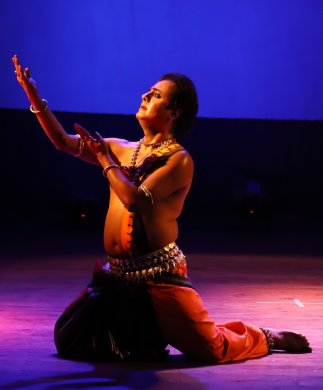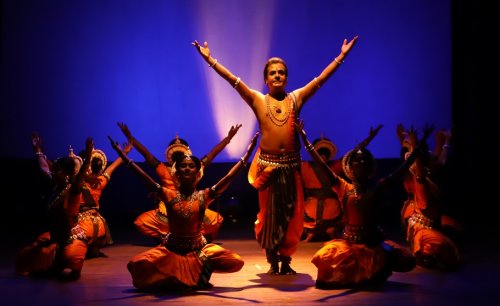
|   |

|   |
 e-mail: ukb7@rediffmail.com Two titans and their travelogues Photos courtesy: Arijit Roy February 2, 2021 Rabindranath Tagore and Swami Vivekananda have been two illustrious icons of our land, who were born only two years apart (1861 and 1863) and both within the perimeters of north Kolkata, but they seldom met. With their ideas and ideologies, they went their own eventful sojourns through life, remaining far away from each other. While Tagore lived a long and fruitful span of eight decades, Vivekananda blazed his trail over just thirty-six years, before coming to rest his mortal remains in Kolkata, not too far from where Tagore would breathe his last. It is interesting to look at what, very broadly, they held in common in their upbringing as well as in their future world views. At a micro level, one shared aspect of their life could be perceived as a common, intense love of music. For Tagore, this spanned over the three genres: classical, Western and folk, from which one could single out classical Dhrupad, learnt early from Jadu Bhatt and Radhika Prasad Goswamy, belonging to Gawhar bani of Vishnupur Gharana and flourishing into a large number of his prayer songs. For instance, Prathama adi taba shakti (Thy primal power, thy primordial luster dazzling the skies...) in raga Sohini (inspired by a Baiju Bawara composition) and Aji bahichhe basanta pawana...(The vernal breeze blows today gently carrying your odor...) in raga Vasant are both Tagore compositions in Dhrupad. In his turn, Vivekananda was surrounded by classical Dhrupad stalwarts of his time, such as Ustad Faiyaz Khan, Ustad Karim Khan, Kali Prasanna Singha, et al. He learnt Dhrupad initially from his singer-father Viswanath Dutta and later from Ustad Ahammad Khan and Ustad Bani Gupta. His lifelong fascination for Dhrupad can be exemplified from the evening prayer of the Ramakrishna order, Khandana bhava bandhana (Liberate us from the earthly bondage...) and Naahi Surja, naahi jyoti... (There's neither sun nor any effulgence nor the beautiful moon...). At a macro-level, both had passionately held secular world views of religion, inclusive and upholding universal values. Here is a vision of Vivekananda taken from his classic 11 September 1893 address at the First Parliament of World Religions in Chicago, "I am proud to belong to a religion which has taught the world both tolerance and universal acceptance. We believe not only in universal toleration, but we accept all religions as true. I am proud to belong to a nation which has sheltered the persecuted and the refugees of all religions and all nations of the earth... I will quote to you, brethren, a few lines from a hymn which I remember to have repeated from my earliest boyhood, which is every day repeated by millions of human beings: 'As the different streams having their sources in different paths which men take through different tendencies, various though they appear, crooked or straight, all lead to Thee'." To Tagore, religion appeared always as a uniting force and not a divisive one. True religion is that which accepts the unity of all people instead of their differences in religious faiths and is inner development of the individual that makes a man to rise above his society, country and sect. True religion is the realization of one's own nature. Tagore never believed in any stratified religious institution and religious practice, whether it was Hinduism or Islam or Christianity. He believed that organized religions may act as a barrier to communal harmony. Tagore's vision of God, unity and equality found spontaneous expression in several of his lectures, addresses, poems as well as in his novels. Here, for instance, are the two opening lines of the second stanza of our National Song: All the while, you liberally call and invite everyone / Hindu-Buddhist-Sikh-Jain-Persian-Muslim-Christian...  Rajiv Bhattacharjee Rabi Kare Bibek Jyoti (Vivekananda Illumined with Tagore's Aura) presented on January 16 by 'Srijan Chhanda' under the noted Odissi dancer Rajiv Bhattacharjee - incidentally as their first venture on proscenium stage coming out of the thralldom of covid virus- attempted to place Tagore and Vivekananda side by side. According to Rajiv, "This is a dance production which has been conceptualised to save the present young generation from the clutches of consistent social erosion with the help of the philosophies propagated by Tagore and Vivekananda, the two great personalities of our country who were both born during the pre-Independence era. Both Tagore and Vivekananda wanted to free India from the dominance of the British rule and highlighted the importance of Indian culture. Although Tagore and Vivekananda never appeared to have met each other, their thoughts were similar in some aspects which are still relevant in today's society. The influence of western culture has impacted our lives in such a way that we are not aware of our own culture and philosophical ideologies at present. Our dance choreography has aimed at highlighting the thoughts of the two great personalities that could help us realise the richness of our culture and the spiritualism attached to it." Rabi Kare presented as an ode to Vivekananda on his 159th birth anniversary, where the choreographer wove an attractive filigree of song-and-dance based on lyrics either composed or just sung by Vivekananda, in a melange with Tagore's compositions or even patriotic songs like Vande Mataram, together with an imaginative mix of audio-visual, sketched projections of the savants Vivekananda and Shri Ramakrishna placed in multiple milieus. Besides very commendable choreographic oeuvre by Rajiv using imaginative angika abhinaya of Odissi, Seema Mukherjee did a competent job of scripting and narration, while Suman Sarkar handled music very well and the redoubtable guru Ratikant Mohapatra played on mardala accompaniment. The presentation began with Khandana Vaba Vandhana..., Vivekananda's prayer song mentioned above, used especially for the daily evening rituals by Ramakrishna Math at Belur. It was an appropriate Mangalacharan choreographed for Rajiv and his cohort of eight dancers with a lot of attention to the details of prayerful rites. The second song Eki andhokar e Bharat bhumi...(How much our motherland is plunged in gloom...) danced as a solo by Rajiv depicted the darkness surrounding the society with conflicting inequalities and violence. The third song Aji e bharata lojjito hey... (India is plunged in shame today...) was also a solo dance by Rajiv, conveying the problems persisting in India and how distressing it was for an ancient land to bear such ignominy and injustice. The fourth song Vande Mataram was a well-known patriotic lyric that narrates the beauty of nature in the form of flora and fauna thriving on India's fertile land. The choreography with seven dancers was quite impressive.  The fifth song Mano chalo nijo niketane...(Let my mind move towards its divine destiny...) was a contemporary Dhrupad sung frequently by Vivekananda for Shri Ramakrishna. The song, danced as a solo again by Rajiv with considerable verve, concentrated on the spiritual journey of a person in quest of the real meaning of life. The sixth song Dui hridoyer nodi... (The streams of the two minds...) was presumably used to show the similarities and differences between the thoughts of Tagore and Vivekananda. The seventh song Kali Kali bolo re aaj..., danced by seven dancers with a lot of vigour, was from an early Tagore play Valmiki Pratibha and used here apparently as an ode to the women of India. Vivekananda wanted women to get all the rights and privileges enjoyed by the men of the society. The eighth song Ta thaiya ta thaiya... was again a Vivekananda composition to describe the rhythms of life, choreographed to represent the 'masculine' aspect of Odissi form. The ninth song Jooraitey chai kothay joorai...(Looking for solace, but where do I get the balm...) was a Tappa song by Tagore, danced as solo by Rajiv showing a clutch of emotions and bringing out the essence of the self in a world full of materialistic pleasures and bound within the five elements. The penultimate song Moha singhasone bosi...(Seated in thy gorgeous throne...) was a group dance offering prayers to the Almighty who has created the world. The final song Naahi surja naahi jyoti..., mentioned earlier and danced by all eight dancers along with Rajiv, was perhaps a realisation that everything was impermanent in this world but for the Supreme Being who has created everything. The human body was transient, but the spirit remained perennial and indestructible. The choreographer opines, "Thus we can see that all the songs that were conceptualised and created in the pre-Independence era were still relevant in the post-Independence period as we are still living in darkness and allowing all the negativity to consume us". While it was a meaningful, nascent effort to generally elucidate Vivekananda's short life span through appropriate songs and dances, it would need some more cohesive work to place the philosophies of the two great souls side by side, as the choreographer had initially set out to accomplish. This critic would wish him bon voyage!  Dr. Utpal K Banerjee is a scholar-commentator on performing arts over last four decades. He has authored 23 books on Indian art and culture, and 10 on Tagore studies. He served IGNCA as National Project Director, was a Tagore Research Scholar and is recipient of Padma Shri. Post your comments Pl provide your name and email id along with your comment. All appropriate comments posted with name and email id in the blog will also be featured in the site. |